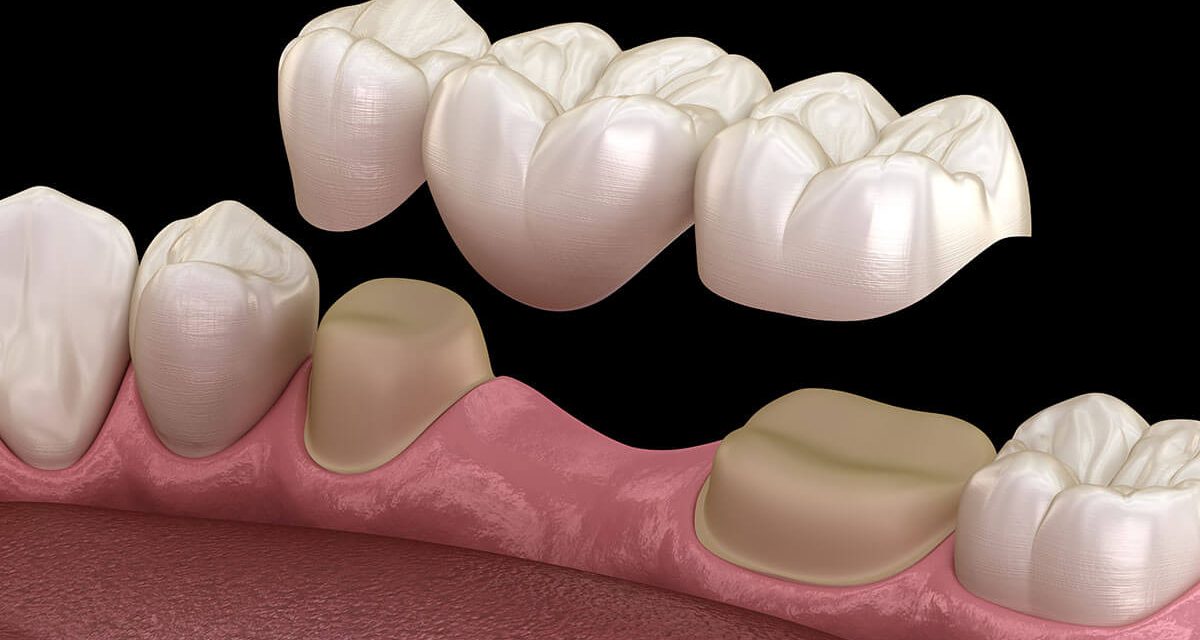A dental bridge replaces missing teeth, and this type of denture comes very close to copying natural dentition. Dental bridges, like tooth crowns or inlays, are part of fixed dentures. Bridges are unique pieces that are individually designed for the patient by close cooperation of the dentist and the technician in a dental laboratory.
The dental technician brings craftmanship, anatomical knowledge and technical expertise to the process. The dental bridge is designed so that it blends harmoniously and aesthetically into the patient’s row of teeth. The patient will hardly be aware of the presence of dentures in his or her mouth.
Read more articles about dentures here.
What is the function of a dental bridge?
If a tooth is missing in a row of teeth, a bridge is created to close the gap. The teeth adjacent to the gap, called abutment teeth, serve as the attachment points for the bridge. They are fitted with crowns and the gap is closed by using a false tooth called the pontic. If more than one tooth is missing, the resultant gap can be bridged in the same way. A well-made dental bridge, of high-quality materials, will remain in the patient’s mouth for many years, provided the patient practises good oral hygiene, and the abutment teeth retain their stability.
Why does a tooth gap have to be closed at all?
If one or more teeth are lost, the patient’s chewing function often suffers. In addition, the stability of other teeth is lost. Teeth that are adjacent can start ‘leaning’ into the gap. Incorrect loads can also result. The opposite tooth in the other jaw can become elongated and start ‘growing’ into the gap. Particularly when an anterior tooth is lost, the patient’s appearance really suffers, and often their pronunciation is also impaired affecting the clarity of their speech. These problems can all be avoided, however, with a bridge. The well-made dental bridge restores the appearance of a natural row of teeth seamlessly in an aesthetically pleasing manner.
How is the treatment done?
At least two treatment sessions are required to provide a bridge. First, the teeth adjacent to the gap are prepared by the dentist to be fitted with crowns to serve as abutments for the dental bridge. This is done very carefully, and only as much of the tooth is ground down as is necessary for anchoring the bridge. Then moulds of the upper and lower jaw are taken and transmitted to the dental laboratory. The affected jaw area is provided with a temporary bridge.
In the dental laboratory, the dental technician creates plaster models and produces a precisely fitting dental bridge. In many cases, it is tested in the patient’s mouth so that the dentist can check the fit and function.

If the bridge meets all the necessary criteria, the dental technician can complete the bridge. The dentist then firmly anchors the bridge to the abutment teeth with a special dental cement. The bridge should work perfectly and give the patient a feeling of chewing naturally.
What material is a tooth bridge made of?
Various materials are available to the dental technician for making the dental bridge. The most suitable material is selected in consultation with the dentist and the patient.
What types of dental bridges are available?
Full-cast dental bridge
This is a dental bridge that can be made entirely of a metal alloy containing precious metals, or alloys free of precious metals. For aesthetic reasons, these bridges are normally just used in the back of the mouth.
Bridges veneered with ceramic
If a tooth-coloured bridge is preferred, ceramic material is used. In the case of a veneering ceramic bridge, a thin metal framework is first created, which is then covered with a ceramic material by the dental technician. The technician builds up the teeth layer by layer using his craftsmanship and knowledge of the anatomy and function of teeth and the mouth. The result is a stable denture that hardly differs in appearance from patient’s natural adjoining teeth.
All-ceramic dental bridge
No metal is used in this highly aesthetic type of bridge. The teeth are made entirely of ceramic material. Here, too, the dental technician’s skill and craftsmanship ensure that the bridge looks natural and beautiful. The light-optical properties of modern ceramics have opened wonderful design options in this regard.
Are there any contraindications to the use of dental bridges?
Having to look after a dental bridge is not recommended for children and adolescents. In addition, a good prognosis for success is less likely in patients who do not practise good oral hygiene. Teeth that do not fit into the jaw very firmly are also a contraindication for anchoring a dental bridge.





